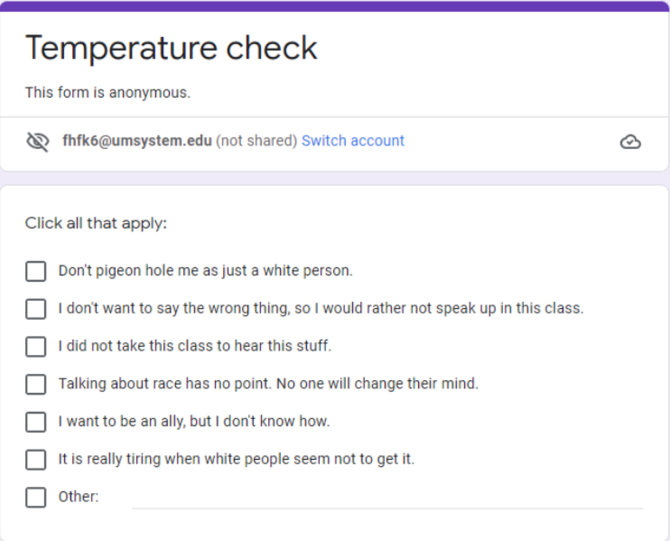
“If we don't address how students are feeling and what they’re going through right now, the content we dive into won't matter to the students,” reports Dr. Thomasina Hassler. “It's not fluff or extra busy work, it's motivating them to engage in the content topics,” she explains about providing avenues for her graduate students to reflect and share how they are feeling.
As the director of the Matthew D. Davis Racial and Social Justice Institute, Dr. Hassler sees the need to provide opportunities for students to navigate their emotions during their learning. New ideas and the challenging of old assumptions certainly provokes emotions and reactions. As educators, we can acknowledge those emotions to help stoke deeper learning.
The need for students to have time to process the content and express their emotions applies to all subject areas. Difficult programming tasks that do not always work out in the end, long statistical analyses that get confusing, an overload of medical terms … for every content area at all levels, we expect students to take on the task of learning.
The process of learning can be a rollercoaster ride ranging from the highs of content mastery to the lows of feeling like you're the only one in the classroom who doesn't "get it." Or to put it another way, cortisol and dopamine levels in your brain influence memory, motivation and learning.
Learners have to go outside their comfort zones to actually learn. As instructors and instructional designers, we can help learners by acknowledging the difficulty of the task and providing them time and space to process their learning and help their peers see their perspective.
In this blog post…
- The Temperature Check activity will be explained. Dr. Hassler implemented it in the synchronous social justice course she teaches.
- Also, a weekly check-in activity using Padlet will be showcased that can be easily adapted for online courses in synchronous, asynchronous or hybrid formats.
- We will leave you with three points to consider before implementing any idea related to the emotional processing of course content, and ask you to share your ideas with us as well.
Temperature Check

In Dr. Hassler’s online graduate course centered on racial and social (in)justice, students are faced with theories and stories that are often heavy or difficult. Often they have experienced parts of what they study firsthand. For some students, however, the course is the first time they encounter these ideas, and they have no direct experience.
Some students engage in the synchronous discussions about course readings, while others choose not to. By implementing this Temperature Check at the beginning of one of her synchronous class sessions, Dr. Hassler allowed students to reflect on how they are feeling about the class discussions. She was able to identify two large groups of students that felt “I don't want to say the wrong thing, so I would rather not speak up in this class” and “It is really tiring when white people seem not to get it.” She acknowledged how the students felt and shared some of the anonymous responses with the class. This activity created a space for her students to reflect on their learning experiences and share how they felt with the class in a safe way.
How to set up a survey in Google Forms
Weekly check-in
While the Temperature Check activity was meant to capture students’ general feelings instantly, the second check-in activity is meant to serve as a space for students to reflect on their emotions as they engage with content throughout the week.

The heading on this Padlet reads: “Our learning is connected with how and what we are feeling. Keep your finger on the emotions you are going through as you engage with course content. Remember you are not alone in what you are going through.”
Students can be encouraged to share when they are feeling frustrated, stuck, lost or overwhelmed as they engage with course material and complete assignments. As a scaffolded activity, columns can be added for students to share when they are feeling optimistic or proud of their accomplishments. Further down the road, students can be encouraged to share what they did when they encountered such feelings. They can share resources and strategies that helped them.
There can be extra points for this activity. The instructor can go over some of the points mentioned by students in the weekly video (in an asynchronous course) or in the synchronous sessions (in a synchronous or hybrid course).
Implementation
Before implementing any idea related to the emotional processing of course content, please take these three points into consideration:
- Be vulnerable and take the first step by sharing yourself.
- Ensure it is a safe space. Explain that you are not looking for a correct answer, and let students know what you will do with what they share.
- Choose a tech tool that allows students to stay anonymous. Google Suite and Padlet are not the only available platforms.
Whether your subject matter is difficult and complex in nature and students tend to struggle with it, or if what you teach can get personal and students tend to have strong opinions about it, chances are there is a lot to unpack in your class.
There are multiple ways to release the pressure of feeling overwhelmed for students and to acknowledge the need to process what they are going through as part of the learning experience. As a learner, what would be the most comfortable way to do this?
*For a deeper dive on the connections between learning and emotions in college classrooms written for instructors in an approachable way, check out The Spark of Learning.
- Fatemeh Mardi, Instructional Designer at Missouri Online
- Jerod Quinn, Higher Ed Instructional Designer
